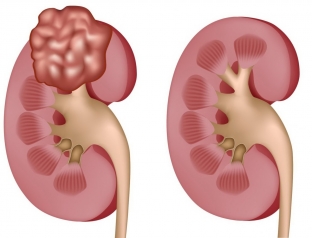Oncological pathology is one of the most important problems of the present time, which is influenced by several main factors. The causes of various tumors are still not fully understood, and the onset of disease symptoms in the late stages and the complexity of the diagnostic process cause an unfavorable prognosis for most patients with oncological pathology. Kidney tumors are a widespread urological problem that requires immediate medical attention. About the types and symptoms of benign kidney tumors tells estet-portal.com.
Main signs of benign kidney tumors
All neoplasms of the kidneys are divided into two large groups: malignant and benign tumors of the kidneys. Benign formations do not cause high mortality of patients, but at the same time they significantly affect the quality of life and the general condition of sick people. Benign kidney tumors are often found & nbsp; accidentally during a routine examination or research for other pathologies, since the clinical picture of these diseases may be absent for a long time. However, even benign kidney tumors need to be detected and treated promptly.
Benign kidney tumors:
- basic information about benign kidney tumors;
- kidney adenoma – a tumor that can develop into cancer;
- The main types of benign kidney tumors.
Basic information about benign kidney tumors
Kidney neoplasms most often occur in children and men between the ages of 40 and 60. Both the left and right kidneys are equally often affected, while no regularities regarding the frequency of damage are detected. Quite often bilateral kidney damage is also diagnosed, while more than a decade can pass from the moment a neoplasm occurs on one kidney to the second kidney is damaged. Benign kidney tumors account for about 6% of all kidney tumors.
Kidney adenoma – a tumor that can develop into cancer
Adenoma is one of the most common benign kidney tumors. This neoplasm is often small and localized in the cortical substance of the kidneys. In most cases, kidney adenoma is asymptomatic, while the clinical picture may occur when the tumor reaches a large size. The main danger of kidney adenoma is that this benign tumor can become malignant, that is, it can turn into a malignant tumor. To date, there are three main classifications of kidney adenoma:
By number of neoplasms:
- single or solitary renal adenoma;
- multiple adenoma with unilateral lesion;
- Multiple adenoma affecting both kidneys.
By cytological features, they are distinguished:
- clear cell adenoma of the kidney;
- dark cell or basophilic adenoma of the kidney;
- acidophilic or eosinophilic adenoma of the kidney;
- granular cell or mixed kidney adenoma.
According to the general histological structure, kidney adenomas are divided into:
- solid or trabecular adenomas;
- tubular adenomas;
- papillary adenomas;
- cystic adenomas;
- fibroadenomas;
- mixed kidney adenomas.

Main types of benign kidney tumors
Other benign kidney tumors are much less common than kidney adenoma, but every practicing urologist should know their main signs and diagnostic methods. There are such rare benign tumors of the kidneys:
- Lipoma – benign tumor, which consists of adipose tissue and is located in the cortical layer of the kidneys. Often the lipoma is asymptomatic and is discovered incidentally. Ultrasound signs of kidney lipoma: round or globular formation in the kidney, with a well-defined capsule and echo-positive white shadows. Kidney lipoma is subject to surgical treatment only in case of its large size.
- Hemangioma – a tumor consisting of blood vessels. In most cases, a characteristic symptom of hemangioma is gross hematuria with the presence of blood clots in the urine. The best method for diagnosing hemangioma is computed tomography. Such a tumor is subject to surgical treatment by performing kidney resection.
- Oncocytoma – benign tumor of the kidney, consisting of epithelial cells with pronounced eosinophilic staining. A specific sign of oncocytoma is the presence of a central stellate scar on computed tomography. The treatment of such a tumor is surgical, the choice of method depends on the size of the neoplasm.
- Angiomyolipomas – These are several types of benign kidney tumors, consisting of blood vessels, muscle cells and adipose tissue in different ratios. The most informative diagnostic method is ultrasound: tumors are visualized as rounded formations with smooth edges, located both inside and outside the kidney. Surgical treatment by performing kidney resection.







Add a comment